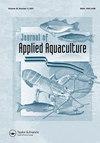Optimization of dietary protein and lipid levels for butter catfish, (Ompok bimaculatus) (Bloch, 1794) fingerlings: An appraisal on growth, body composition, digestive enzymes, and metabolic function
IF 0.8
Q3 FISHERIES
引用次数: 0
Abstract
ABSTRACT A completely randomized 3 × 3 factorial feeding trial was conducted to evaluate the effects of dietary protein and lipid levels on growth, feed utilization, body composition, and digestive as well as metabolic enzymes of the butter catfish (Ompok bimaculatus) fingerlings. Fish (average weight 0.66 ± 0.12 g; 30 d) were fed nine experimental diets containing three protein levels (35%, 40%, 45%) and three lipid levels (5%, 10%, 15%) in triplicate groups for a period of 90 days. The formulated diets were named P35L05, P35L10, P35L15, P40L05, P40L10, P40L15, P45L05, P45L10, and P45L15 (P = Protein; L = Lipid) respectively. The results indicated no protein-sparing effect of lipid in O. bimaculatus fingerlings beyond 35% dietary protein. Overall, diets P40L5 and P35L10 had significantly (P < 0.05) higher SGR (% day−1) and lower FCR than other experimental groups. The highest weight gain (10.89 ± 0.07 g) and carcass protein (16.71 ± 0.2%) were recorded in fish fed diet P40L05. Increasing dietary lipid levels brought about an increase in carcass lipid in fish. Activities of α-amylase and acid-protease were decreased (except at 5% lipid), whereas alkaline-protease was increased with increasing dietary protein. An increase in pyruvate kinase (PK, glycolytic enzyme) activity and decrease in glucose-6-phosphate dehydrogenase (G6PD, lipogenic enzyme) activity were noticed with increasing dietary lipid content. A decrease in PK and increase in G6PD activities were observed with increasing dietary protein levels. Activities of the gluconeogenic enzymes (glucose-6-phosphatase, fructose-1,6-phosphatase) increased significantly (P < 0.05) with increasing dietary protein and lipid levels. Amino acid catabolizing enzymes, alanine transaminase and aspartate transaminase, were slightly increased with increasing dietary protein levels. Considering growth, body composition, metabolic function, and survivability (>95%), the diet containing 40% crude protein with 5% lipid might be suggested as optimum for O. bimaculatus fingerlings under the tested conditions.优化黄油鲶(Ompok bimaculatus)(Bloch,1794 年)幼鱼的日粮蛋白质和脂质水平:对生长、身体成分、消化酶和代谢功能的评估
摘要 进行了一项完全随机的 3 × 3 因式饲养试验,以评估日粮蛋白质和脂质水平对黄油鲶(Ompok bimaculatus)幼鱼的生长、饲料利用、体成分、消化酶和代谢酶的影响。鱼类(平均体重 0.66 ± 0.12 g;30 d)以一式三份的组别饲喂含有三种蛋白质水平(35%、40%、45%)和三种脂质水平(5%、10%、15%)的九种实验日粮,为期 90 天。配制的日粮分别命名为 P35L05、P35L10、P35L15、P40L05、P40L10、P40L15、P45L05、P45L10 和 P45L15(P = 蛋白质;L = 脂质)。结果表明,当日粮蛋白质含量超过 35% 时,脂质对双尾鳕幼鱼没有蛋白质保护作用。总体而言,与其他试验组相比,P40L5 和 P35L10 日粮的 SGR(% day-1)显著较高(P < 0.05),而 FCR 则较低。饲喂 P40L05 日粮的鱼类增重(10.89 ± 0.07 g)和胴体蛋白质(16.71 ± 0.2%)最高。日粮脂质水平的增加导致鱼体脂质的增加。随着日粮蛋白质的增加,α-淀粉酶和酸性蛋白酶的活性降低(脂质含量为 5%时除外),而碱性蛋白酶的活性增加。随着日粮脂质含量的增加,丙酮酸激酶(PK,糖酵解酶)活性增加,葡萄糖-6-磷酸脱氢酶(G6PD,脂肪生成酶)活性降低。随着日粮蛋白质含量的增加,PK 活性降低,G6PD 活性升高。随着日粮蛋白质和脂质含量的增加,糖元生成酶(葡萄糖-6-磷酸酶、果糖-1,6-磷酸酶)的活性显著增加(P < 0.05)。氨基酸分解酶(丙氨酸转氨酶和天门冬氨酸转氨酶)随着日粮蛋白质水平的增加而略有增加。考虑到生长、体成分、代谢功能和存活率(>95%),在试验条件下,粗蛋白含量为 40%、脂质含量为 5%的日粮可能是最适合双尾鳕幼鱼的日粮。
本文章由计算机程序翻译,如有差异,请以英文原文为准。
求助全文
约1分钟内获得全文
求助全文
来源期刊

Journal of Applied Aquaculture
Environmental Science-Ecology
CiteScore
3.20
自引率
0.00%
发文量
38
期刊介绍:
The Journal of Applied Aquaculture is a platform for the sharing of practical information needed by researchers to meet the needs of investors, farm managers, extension agents and policy makers working to adapt aquaculture theory to achieve economic and food security objectives in the real world. The journal emphasizes multi-disciplinary research and case studies that propose financially and logistically viable solutions to observable problems.
 求助内容:
求助内容: 应助结果提醒方式:
应助结果提醒方式:


